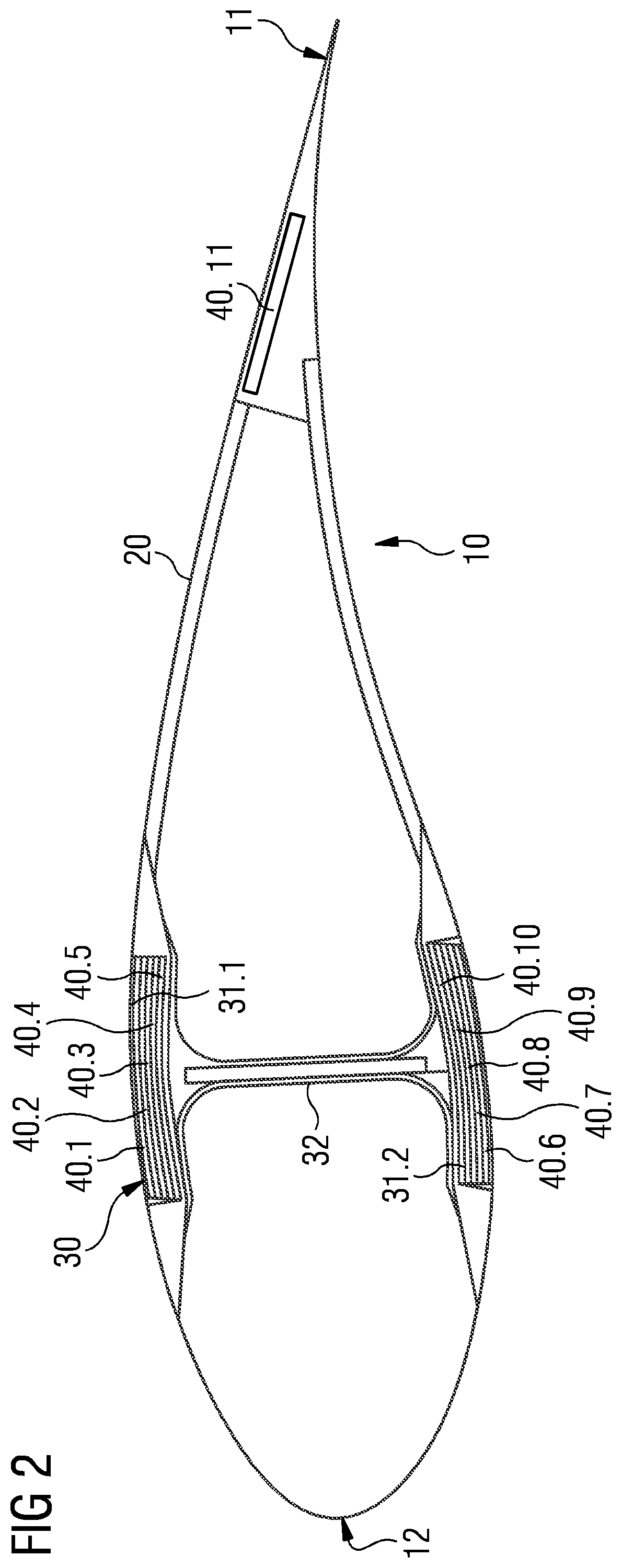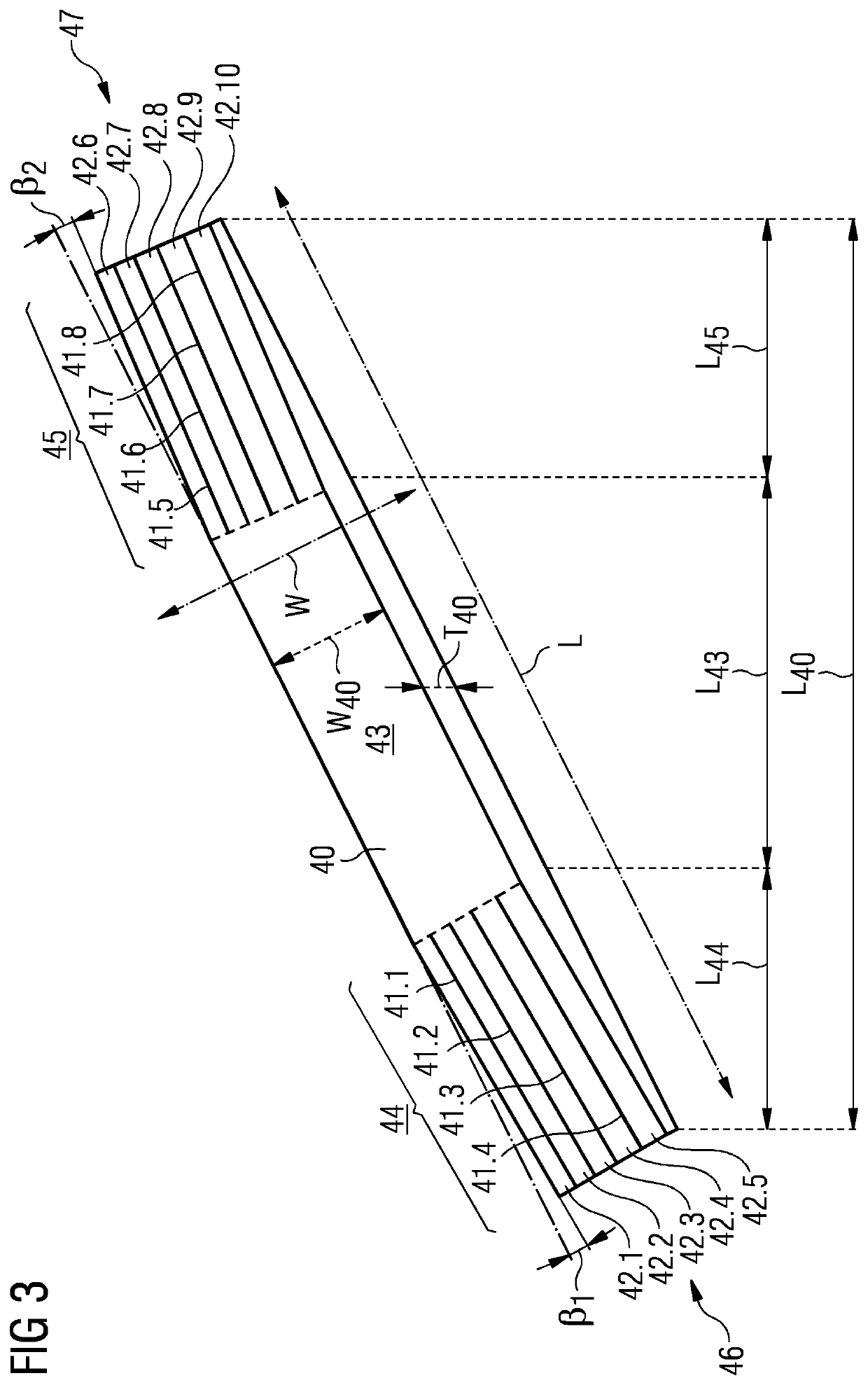Beam for a wind turbine blade, wind turbine blade, wind turbine, method for manufacturing a beam for a wind turbine blade and method for manufacturing a wind turbine blade
a technology for wind turbine blades and beams, which is applied in the manufacture of final products, machines/engines, wind turbine blades, etc., can solve the problems of wind turbine blade failure, high specific modulus composite materials are typically more expensive and more difficult to manufactur
- Summary
- Abstract
- Description
- Claims
- Application Information
AI Technical Summary
Benefits of technology
Problems solved by technology
Method used
Image
Examples
first embodiment
[0038]FIG. 3 is a side perspective view on a beam 40 according to embodiments of the invention. Such a beam 40 may be used as one, several or all of the beams 40.1, 40.2, 40.3, 40.4, 40.5, 40.6, 40.7, 40.8, 40.9, 40.1, 40.11 in the wind turbine blade 10 of FIG. 2. In this particular embodiment, the beam 40 is a pultruded element made from carbon fiber-reinforced plastic.
[0039]The beam 40 has a longitudinal mid-section 43, a first recessed longitudinal end section 44 and a second recessed longitudinal end section 45. The longitudinal mid-section 43 is arranged in between the first recessed longitudinal end section 44 and the second recessed longitudinal end section 45. The first recessed longitudinal end section 44 extends to a first longitudinal end 46 of the beam 40 and the second recessed longitudinal end section 45 extends to a second longitudinal end 47 of the beam 40. The length of the beam 40 is the sum of the length L43 of the longitudinal mid-section 43, the length L44 of th...
second embodiment
[0043]FIG. 4 is a side perspective view on a portion of a beam 40 according to embodiments of the invention. Ten longitudinal recesses 41.1, 41.2, 41.3, 41.4, 41.5, 41.6, 41.7, 41.8, 41.9, 41.10 are arranged parallel to one another in the longitudinal direction of the beam 40, whereby the longitudinal recesses 41.1, 41.2, 41.3, 41.4, 41.5, 41.6, 41.7, 41.8, 41.9, 41.10 separate the beam 40 into eleven adjacent longitudinal beam portions 42.1, 42.2, 42.3, 42.4, 42.5, 42.6, 42.7, 42.8, 42.9, 42.10, 42.11. The longitudinal recesses 41.1, 41.2, 41.3, 41.4, 41.5, 41.6, 41.7, 41.8, 41.9, 41.10 and the longitudinal beam portions 42.1, 42.2, 42.3, 42.4, 42.5, 42.6, 42.7, 42.8, 42.9, 42.10, 42.11 have the tapered thickness T40 of the beam 40 at their respective location. The longitudinal recesses 41.1, 41.2, 41.3, 41.4, 41.5, 41.6, 41.7, 41.8, 41.9, 41.10 are arranged in the first recessed longitudinal end section 44 having the first longitudinal end 46. The second longitudinal end 47 of the...
PUM
 Login to View More
Login to View More Abstract
Description
Claims
Application Information
 Login to View More
Login to View More - R&D
- Intellectual Property
- Life Sciences
- Materials
- Tech Scout
- Unparalleled Data Quality
- Higher Quality Content
- 60% Fewer Hallucinations
Browse by: Latest US Patents, China's latest patents, Technical Efficacy Thesaurus, Application Domain, Technology Topic, Popular Technical Reports.
© 2025 PatSnap. All rights reserved.Legal|Privacy policy|Modern Slavery Act Transparency Statement|Sitemap|About US| Contact US: help@patsnap.com



